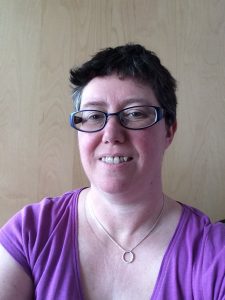 Having looked at a huge range of universities and the courses on offer I decided to apply for the MSc Science Communication and Society at the University of Kent. I chose this particular course as it offered an opportunity to study a combination of Biosciences and History modules allowing me to gain a fantastic insight into how these different disciplines are interconnected. My BSc was in Food and Nutrition and I wished to progress towards looking at the impact of food throughout history. While I really enjoyed the Biosciences modules available and found Dan Lloyd a brilliant lecturer, I took more of the history modules as they allowed me to delve into a different area from my scientific Bachelors degree. The optional modules on offer were incredibly interesting and it was very difficult to choose, but I settled on Deformed, Deranged and Deviant, which examined changing medical science and attitudes towards people who were ‘different’. The module was a fascinating insight into a delicate and sensitive subject. I also chose Places, Spaces and Things: Museums, Material Culture and the History of Science module, which really challenged me to think and look at museums and places of science from a new perspective. As a member of a Heritage Group in my town, with plans to start a local museum, this module will prove invaluable in helping me to contribute to my community. Kent has been supportive, enjoyable, challenging and mind expanding! I have great respect for the lecturers here who have developed the MSc Science Communication course as it opens a path between Science and Humanities and allows students to discover the connections between these two disciplines. The knowledge gained on this course has enabled me to gain a PhD scholarship in History where I will be researching food in rural Kent during the Second World War.
Having looked at a huge range of universities and the courses on offer I decided to apply for the MSc Science Communication and Society at the University of Kent. I chose this particular course as it offered an opportunity to study a combination of Biosciences and History modules allowing me to gain a fantastic insight into how these different disciplines are interconnected. My BSc was in Food and Nutrition and I wished to progress towards looking at the impact of food throughout history. While I really enjoyed the Biosciences modules available and found Dan Lloyd a brilliant lecturer, I took more of the history modules as they allowed me to delve into a different area from my scientific Bachelors degree. The optional modules on offer were incredibly interesting and it was very difficult to choose, but I settled on Deformed, Deranged and Deviant, which examined changing medical science and attitudes towards people who were ‘different’. The module was a fascinating insight into a delicate and sensitive subject. I also chose Places, Spaces and Things: Museums, Material Culture and the History of Science module, which really challenged me to think and look at museums and places of science from a new perspective. As a member of a Heritage Group in my town, with plans to start a local museum, this module will prove invaluable in helping me to contribute to my community. Kent has been supportive, enjoyable, challenging and mind expanding! I have great respect for the lecturers here who have developed the MSc Science Communication course as it opens a path between Science and Humanities and allows students to discover the connections between these two disciplines. The knowledge gained on this course has enabled me to gain a PhD scholarship in History where I will be researching food in rural Kent during the Second World War.
Sep 28
Food science: then and now
Sep 27
Wunderkammer Autumn 2016
Here are this term’s Wunderkammer sessions. We’ll be discussing the History Manifesto, SciArt, early-modern globalisation, transhumanism and the history of peer review. We meet every other Tuesday, from 17.30-19.00, in the Unicorn pub, Canterbury. Full details on the pdf wunderkammer_autumn_2016
Jul 01
‘Visualising dynamic theories, what diagrams of molecular pathways represent’ by Filippo Guizzetti
Visualisation is a constitutive and essential part of the scientific activity. From basic research to the production of evidences (Amann and Knorr Cetina 1988), from the development of scientific theories to the stage of public evaluation, several methods of representation are the root from which the scientific discourse unfolds (Pauwels 2006, p.vii; Lynch 1988, p.153). Molecular pathways’ diagrams are a unique mixture of different forms of representation. They involve drawings, graphs, and diagrams, showing a dynamic process rather than a static and lasting entity. This essay will show that visualisation, interpretation and representation of scientific data is an active and knowledge-based process driven by pre-existing theories. Molecular pathways representations can be considered an effective way through which scientists display their interpretations, expectations and beliefs on molecular processes particularly difficult to visualise (Amann and Knorr Cetina 1988, p.86). Two diagrams representing a specific pathway will be analysed and compared to another type biological representation. Furthermore, it will be shown how the representations choices used for these diagrams reflect the audience of scientific experts they address. Finally, divergent points of view on to what extent theory-based and theory-driven observations can be considered reliable scientific facts will be presented. Using texts by Lynch, Hacking and other authors, molecular pathways representation will be debated as a particularly effective example demonstrating that empirical observations and theoretical knowledge are the two complementary and inseparable side of scientific investigation. Through the guide of scientific knowledge, these representations do not aim to crystallise theories, but to provide opportunities for scientific discussions and further investigations.
A constitutive feature of scientific activity is the production of visual representations of objects of study, processes and theories. Scientific publications always include images and illustrations that are irreplaceable documents enabling to perceive and analyse the object of study (Lynch 1985, p.195). In science, visualisation is performed using diverse techniques such as photographs, graphs, diagrams, maps, drawings, documents produced during laboratory research and illustrations included in published papers (Lynch 1998, p.27). Among these numerous forms of scientific visualisation, diagrams of molecular pathways constitute a unique and particularly interesting example. As the American NHGRI’s (National Human Genome Research Institute) website defines it, a biological pathway represents a series of actions and interactions among molecules (such as proteins, nucleic acids, simple molecules, chemical compounds and so on) taking place inside a cell and leading to a certain resulting change or effect in the cell itself (NIH National Human Genome Research Institute 2016). Typical “effects or changes” that molecular pathways trigger are inflammatory responses, assembly of new molecules, change in the DNA expression profile of a cell by turning specific genes on and off and myriad of other processes.
The processes necessary for visualising the components of these interactions, interpreting the data and effectively visualise these complex and dynamic networks would not be possible without a specific scientific knowledge. Moreover, some expectations and theories guiding research and interpretation are always necessary. As will be shown further in the text, molecular pathways can be considered representation of scientific theories rather than visualisation of “objects of science”. Considering these “visual dynamic theories” as trustworthy, therefore, involves relying on instrument of science investigations (Woolgar 1988, pp.31-33).
Visualisation in science involves several practices “associated with making objects observable and intelligible” (Lynch 1998, p.27). Observing is the fundamental activity that enables scientists to interpret the biological world, yet the human eye’s resolution limit varies between 0.1-0.3mm. Hence, in order to pursue studies in the biology field, it is necessary to use instruments such as the microscope enabling to see what is invisible (Bastide 1990, p.189). Microscopes and other visualisation techniques used in science allow scientists to closely observe the object of study and, thus, to accurately represent it and communicate it to other minds (Pyle 2000, p.69). Since the observational experience of biological specimens is possible only through the use of artificial organs, it will always be inevitably mediated by these instruments (Chalmers 1982, p.23). Furthermore, optical microscopies cannot be used when observing structures as small as molecules, viruses or cell’s organelles, all constituting element of biological pathways. In these cases, it is necessary to use more sophisticated techniques such as electronic microscopy, or photographic developing procedures like the Western blotting, used for visualising proteins’ presence and amount. Nevertheless, it is not the object itself what these instruments make observable, but its “trace” (Bastide 1990, p.189). A specialised knowledge is then necessary not only for using the instrument, but also – and especially – for interpreting the signal generated by this instrument, distinguishing and isolating it from the background and other signals (Hacking 1981, p.308). Every act of looking is, therefore, in itself an act of active interpretation that would not be possible without a prior knowledge enabling to use an “artificial organ” such as the microscope (Kemp 2000, pp.42-43). Microscopes – and other instruments – are an extension of individual sense organs through which the skilled scientist can see or feel what the instrument discloses (Polanyi 1967 quoted in Lynch 1998, p.28).
The study of biological structures is, therefore, possible only through the use of highly sophisticated observational instruments that, however, enable scientists just to observe the trace of the object of study that, subsequently, need to be interpreted. Can we, thus, consider the use of these instruments as an act of seeing (Amann and Knorr Cetina 1988, p.86)? Do microscopes provide scientific realism about what could not be observed otherwise (Hacking 1981, p.305)? Microscopes and other instruments don’t allow for a direct interaction with reality, but just a projection of it (Bloor 1976, p.40). Through this process, the focus is moved to the “externalised retina”, that is the graphic field on which the “trace” is displayed (Lynch 1988, p.154). Hacking (1981) defends the act of observation through a microscope by claiming that its reliability lies on what the very act of observing is. Observation is not a passive experience, but an active procedure; a skill that is learned “by doing, not just by looking”. Scientists need to be trained and educated to interpret the partial image that they see, distinguish artefacts form real objects (Hacking 1981, p.310). To see means to recognise and linguistically identify an object, a process in which sense data emerging from an experiment or observation are translated into more solid evidences (Amann and Knorr Cetina 1988, p.85-88). Observation is, and must be, guided by the scientist’s skills, experience and expectations, (Bloor 1976; Chalmers 1982, p.23) in which his or her perception works as a filter that selects, simplifies and translates a chaotic world into perceiver’s projects and interests (Lynch 1988, p.155-156). Biological pathways fit perfectly in this theory of observation. Investigation on these events is guided by scientists’ theories, skills and ideas (Bloor 1976, p.25) and their representation is the final result of a process of translating data into evidences; evidences enabling a theory about a complex molecular network to be meticulously investigated.
Studying molecular hypothetical interaction networks is a complex, long and theory-based process of interpreting data, scientifically verify interactions between molecules, translate these connections into solid evidences and represent the subsequent final improved theory in the most effective way. But when studying pathways, what actually are the observable biological objects of study? The biological elements interacting in molecular pathways made visible thanks to scientific instruments are, using Lynch and Woolgar, not natural objects, but “proximal things”: “residues impressed on graphic matrices”, ordered and filtered samples, photographic traces and chart recordings; in other words, “resemblance or symbolisations of external objects” (1990, p.5). These data act as the basis for subsequent interpretations and discussions (Amann and Knorr Cetina 1988, p.90-93). Conventions, then, allow for making the object of study visible and analysable by fitting the raw visual data into the disciplinary organisation of scientific theories (Lynch 1998, p.196). Through this process, an observation, driven and filtered by a pre-existing theory, allows a new visualisation and representation of a biological object of study. What could, thus, be a final representation of a biological object?
Just as visualisation in science research is an active process transforming specimen materials into analysable data (Lynch 1985 p. 195), the final representation of scientific findings and theories is not just a simple replication of reality. Visualisation of scientific knowledge aims to reveal reality, to make it more understandable and accessible. Visual representation in science does not seek to be a replica of nature, but to resolve a problem, fill gaps in knowledge, or facilitate knowledge building and communication (Pauwels 2006, p.viii). Indeed, what scientists know about their object of study and what they want to communicate about it is expressed in the way they represent it (Lynch 1998, p.32; Trumbo 1999, p.270). The image in figure 1 represent this very effort.
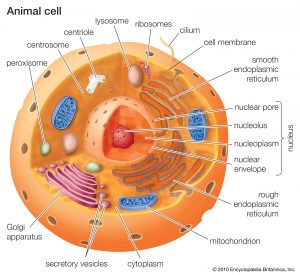
Figure 1. Schematic representation of an animal cell. Encyclopaedia Britannica, 2010. kids.britannica.com
Figure 1 shows the representation of a mammal cell from the children section of Encyclopaedia Britannica (Encyclopaedia Britannica Kids, 2010). The cell depicted in this diagram is not a real one, from a specific tissue with specific features, but the ideal cell, partially sectioned in order to show every basic feature that composes mammal cells. The white, neutral background helps to focus the attention on the image (Bastide 1990, p.200-203), while the use of several bright and unnatural colours and oversized inner structures makes it easier to identify the organelles in the different cell’s regions (Amann and Knorr Cetina 1988, p.112). Finally, thin lines connect the details to their linguistic identifications that surround and frame the image. What we see is not realistic, but an idealisation of an existing object that can be indirectly observed and visualised through the use of specific instruments. It represents a movement from the particularity of one observation to the generality of a scientific claim (Myers 1988, p.235-240). While in this image the process enabling these biological structures to be visualised is hidden (Lynch 1998, p.28), the knowledge that it represents is effectively concretised and communicated (Cambrosio et al 2005, p.187; Kemp 2000, p.120).
Pathways diagrams are created using these same visualisation concepts and guidelines. Nevertheless, pathways representation lies on a profoundly different level of complexity and abstraction. While the image in figure 1 is the idealisation of a lasting and observable biological structure, molecular pathways are phenomena, dynamic events in which the interaction between the participants begins, evolves and terminates during a finite period of time. Scientists can only observe the traces of these actions, by distinguishing and comparing data obtained before and after a process have taken place. These visualisations, then, must include the time dimension in order to explain processes that can be – only indirectly – observed in highly sophisticated ways. Graphs are the most used form of visualisation for such purposes since they can support more dimensions while remaining readable (Bastide 1990, p.206, pp.213-220).

Figure 2: A schematic representation of the JAK-STAT pathway in the activated state (particular). Shuai and Liu 2003, p.901
The image in figure 2 is a representation diagram of the JAK-STAT molecular pathway taken from a review article published on the scientific journal Nature Reviews (Shuai and Liu 2003, p.901). The graphic design is, to a certain extent, similar to the one used for the animal cell in figure 1, whereas the differences between these two images help to highlight the key features of pathways representation. First of all, it is clearly noticeable that the target audience of these two images is completely different. While the cell image was included in an educational publication for children, the image in figure 2 comes from a scientific journal targeting an audience of scientific experts (Lynch 1988, pp.153-154). This difference is further underlined by the fact that while the cell image provides taxonomical annotations, the pathway diagram is completely indecipherable without a specific background knowledge. Both the images need to be contextualised by being integrated in a further explaining text (Bastide 1990, p.193-197); yet they are conceived in order to be identified and understood at a first glance by the audience they are targeting (Myers 1988, p.247).
Focusing on the pathway diagram, several elements worth being highlighted. The horizontal structure made of dots is a schematic representation of the cell membrane’s double layer dividing the extracellular space (white background) from the cytoplasm (green background); the nucleus is yellow and its membrane shows interruptions suggesting that the proteins involved in the pathway are able to pass through it. Indeed, the proteins constitute the core of the image and of the pathway as well. In order to highlight the concept over the representational accuracy (Myers 1988, p.240), proteins are represented as simple geometrical, two-dimensional and out of proportion objects with peculiar colours and shapes distinguishing them (Lynch 1988, p.168). They are also tagged with an acronym that stands for the complete name (e.g. JAK: Janus Kinase; STAT: Signal transducer and activator of transcription) (Amann and Knorr Cetina 1988, p.114). The key aspect of time, peculiar point of these diagrams, is represented using arrows and the vertical orientation of the image that must be read from top to bottom as a cascade of events (Myers 1988, p.247-249). An arrow connects a protein in its initial state (STAT on the left) to the same protein in a modified form (on the right), where an amino acid Tyrosine (Y) is modified (“phosporylated”) by the addition of a little P that stays for a phosphate groups. This transformation is triggered by the cytokine receptor, coupled with the cytokine (a small molecule working as a inter-cellular signal) and JAK proteins. Another arrow shows the movement of two modified STATs going inside the nucleus and triggering the final result of the entire pathway: a modification in DNA transcription (Bastide 1990, p.219-220).
Clearly, this is not an accurate representation of natural objects, nor is an idealisation of something that can be isolated and observed as it was for the animal cell in figure 1 (Lynch 1998, p.30-31). Pathways are a deep mathematical, visual and symbolic reconstruction of a phenomenon’s organisation (Lynch and Woolgar 1990, p.6; Cambrosio et al 2005). Their representations must be addressed more as a translation of a verbal argument into a visual discourse that unfolds through symbols and connections, as it would be for logic studies in philosophy (Lynch 1998, p.30; Lynch 1988, pp.160-162; Allchin 1999, p.291). Thanks to the acquisition of arrows and other symbols, diagrams become narrative and dynamic describing processes that, just as a theory or a discourse, have a beginning and an end (Kress and Van Leeuwen 1996, pp.83-83). They are logical demonstration visualised through a process of “figuration” (Cambrosio et al 2005, p.189).
Since it has been show that pathways diagrams are articulated visualisations closer related to a form of visual discussion on a theory than to an object’s representation, this means that a single diagram can be improved or modified in order to show different or new aspects of the theory it visualises.

Figure 3: A schematic representation of the JAK-STAT pathway in the inhibited state. Shuai and Liu 2003, p.903
Figure 3 shows another image of the same JAK-STAT pathway taken from the same article (Shuai and Liu 2003, p.903). It can be seen that the main surrounding structures (cell membrane, cytokine receptor, nucleus) and the backgrounds are the same as in figure 2. This is an important aspect that makes us instantly understand that we are talking about the same topic and theory. However, instead of showing the pathway mechanism in its working state, it shows in what way this network is negatively regulated. New proteins are represented with new colours and a new organelle, the proteasome, is visible. There is also a new logic symbol that looks like a flipped “T”. This symbols derives from the modified Systems Biology Graphical Notation (mSBGN) and represents an inhibition influence on a target, in opposition to the arrow that represents stimulation or a transition from a state to another (SBGN.org). The addiction of this simple symbol enables the possibility of more articulated discourses and improves the visual representation.
It is now clear that the research on these molecular phenomena is embedded in and guided by pre-existing theories generated by scientists’ past experiences, knowledge and expectations (Chalmers 1982, p.25; Bloor 1976, p.30). This means that the same philosophical problems that sociologists and philosophers have raised for addressing scientific theories affect also the diagrams in which these theories are embodied. Chalmers firmly states that “theory of some kind must precede all observation statements and observations statements are as fallible as the theories they presuppose” (Chalmers 1982, p.28). Since observations are permeated by theory, it could be presumed that only those observations that can confirm and shed more light on a pre-existing theory are carried out, while those considered misleading are ignored (Chalmers 1982 pp.32-33; Bloor 1976, p.25). Even on the representation and publication stage, scientists can choose what to show and what to hide in order to reinforce their theories (Morus 2006, p.105).
Considering these aspects, can representations of dynamic invisible processes be reliable? The fact that representations deriving from scientific researches and observations, especially concerning complex and elusive phenomena as molecular interactions networks, are based on and driven by theories and expectations does not imply that these observations and findings are purely fictional (Amann and Knorr Cetina 1988, p.114). On the contrary, ideas and theories are needed in order to use scientific instruments, to interpret the data that they produce and to formulate and improve conception on what we see rather than just seeing it (Hacking 1981 315-316; Pyle 2000, p.69). The image, even though “fabricated”, is the way of “visually reproducing the sense of what was seen”, which is a longer process made of numerous observations, comparison and discussions involving several scientists. Through a process of “visual thinking”, production of scientific images is incorporated as a part of conscious thoughts, deciding what shapes, lines, colours and compositions to use for making them meaningful (Trumbo 1999, p.269). Visual evidences don’t work as a way to visually crystallise theories, but providing opportunities for discussions and further investigations (Amann and Knorr Cetina 1988, pp.114-115).
The study of biological molecular interactions would not be possible without the use of highly sophisticated instruments enabling scientists to visualise what is invisible and to extrapolate from the biological chaos a “docile object” (Lynch 1985, p.201). It has been shown in this essay that every aspect of the research on molecular pathways, from their observation and confirmation in the laboratory, to the graphical visualisation of the hypothetical process, needs a specific and advanced knowledge capable of interpreting and deciphering it. Pathways diagrams are a unique form of visual discourses representing scientists’ theories, ideas and expectations. They are as fallible as the theories they represent. Nonetheless, their presence in scientific articles is crucial in order to effectively communicate these theories and how they were conceived. Although “fabricated”, this mathematical representations and the scientific data they present are not fictional (Amann and Knorr Cetina 1988, p.114). Through the process of visual thinking, production of such scientific images is incorporated as a part of conscious thoughts helping the improvement of the scientific practice by sharing knowledge and triggering discussions, investigations and new researches.
Filippo Guizzetti (2016)
References:
- Allchin, Douglas. 1999. “Do We See through a Social Microscope? Credibility as a Vicarious Selector”. Philosophy of Science 66: S287-S298. University of Chicago Press. doi:10.1086/392732.
- Amann, K. & Knorr Cetina, K. 1988. “The fixation of (visual) evidence”. In Representation in scientific practice, pp.85-122. Lynch, Michael & Woolgar, Steve. 1990 Mass.: MIT Press.
- Bastide, François. 1990. “The iconography of scientific texts: principles of analysis”. In: Representation in scientific practice, pp.187-230. Lynch, Michael & Woolgar, Steve. 1990 Mass.: MIT Press
- Bloor, David. 1976. Knowledge and social imagery, pp.24-45. London: Routledge & K. Paul.
- Cambrosio, Alberto; Jacobi, Daniel & Keating, Peter. 2005. “Arguing with Images: Pauling’s Theory of Antibody Formation”. In Visual cultures of science, pp.153-194. Pauwels, Luc, Hanover, N.H.: Dartmouth College Press.
- Chalmers, A. F. 1982. What is this thing called science? pp.22-37 Indianapolis: Hackett Pub.
- Encyclopaedia Britannica Kids. 2010 “Eukaryote: animal cell”. kids.britannica.com. http://kids.britannica.com/elementary/art-112877/Cutaway-drawing-of-a-eukaryotic-cell.
- Hackin, Ian. 1981. “Do we see through a microscope?” Pacific Philosophical Quarterly 62:305-322.
- Kemp, Martin. 2000. The Nature book of art and science. Oxford: Oxford University Press.
- Kress, Gunther R & Van Leeuwen, Theo. 1996. Reading images, chapter 3 pp.79-113. London: Routledge.
- Lynch, Michael. 1998. “The production of scientific images. Vision and Re-vision in the History, Philosophy and Sociology of Science”. In Visual cultures of science, pp.26-40. Pauwels, Luc, Hanover, N.H.: Dartmouth College Press.
- Lynch, Michael. 1988. “The externalized retina: Selection and mathematization in the visual documentation of objects in the life sciences”. In Representation in scientific practice, pp.153-186. Lynch, Michael & Woolgar, Steve. 1990 Mass.: MIT Press.
- Lynch, Michael & Woolgar, Steve. 1990. Representation in scientific practice. Cambridge, Mass.: MIT Press.
- Morus, Iwan Rhys. 2006. “Seeing and Believing Science”. Isis 97 (1): 101-110. University of Chicago Press. doi:10.1086/501103.
- Myers, Greg. 1988. “Every picture tells a story: Illustrations in E.O. Wilson’s Sociobiology”. In: Representation in scientific practice, pp.231-266. Lynch, Michael & Woolgar, Steve. 1990 Mass.: MIT Press
- NIH National Human Genome Research Institute. 2016. “Biological Pathways Fact Sheet”. genome.gov. https://www.genome.gov/27530687.
- Pauwels, Luc. 2006. Visual cultures of science. Hanover, N.H.: Dartmouth College Press.
- Pyle, Cynthia M. 2000. “Art as science: scientific illustration, 1490–1670 in drawing, woodcut and copper plate”. Endeavour 24 (2): 69-75. Elsevier BV. doi:10.1016/s0160-9327(99)01262-4.
- Shuai, Ke & Liu, Bin. 2003. “Regulation of JAK–STAT signalling in the immune system”. Nat Rev Immunol 3 (11): 900-911. Nature Publishing Group. doi:10.1038/nri1226.
- Trumbo, Jean. 1999. “Visual Literacy and Science Communication”. In: Visual cultures of science, pp.266-284. Pauwels, Luc, Hanover, N.H.: Dartmouth College Press.
- Woolgar, Steve. 1988. “Representation and methodological horrors”. In Science, the very idea, pp.30-38. Chichester, Sussex: Ellis Horwood.
Apr 06
‘Describing Albrecht Dürer’s Philosophy and Practice of Drawing and to What Extent His Drawings Reflect the Way Nature was Perceived at the Time’ by Larissa Warneck
Introduction
Albrecht Dürer was one of the leading artists of the Renaissance. His innovative ideas in geometry and the proportion of the human body, his realistic representation of nature, and his imagination in probing new printing techniques, lead to his reputation as the Leonardo Da Vinci of Northern Europe. In this essay I am going to describe different aspects of Dürer’s philosophy and practice of drawing, and embed his artworks into the understanding of nature at the time.
Setting the Scene
At a time in which the world people knew was rapidly changing – with new landmasses being discovered, expeditions returning with exotic never before seen objects and more people on the move – art was used as a medium to vent this newly formed uncertainty, to bring order to confusion. The Renaissance was therefore a period which, on the one hand, was still anchored within the features of classic Antiquity, whilst at the same time, it was being unhinged by the after shocks of the discovery of the New World (Keller, 1972, 11; Sleigh, 2016, 1). Society was rapidly adapting to new philosophical concepts and ideas, as new technological developments increased and the traditional views on nature and its place in the Universe were suddenly being questioned (Eichberger, 1998, 13-14).
Contemporary artists such as Albrecht Dürer, Leonardo Da Vinci or Conrad Gessner sought to incorporate the changing aspects of this period into their art, an art that had undergone a dramatic change. The new way of painting shifted from the former “elegant and graceful gothic style characterised by figures of dignified beauty” and “rich with precious decorations often of pure gold”, to scenes which were full “of passion, of pain, of sentiments, and full of life” (Tonelli, 2013, 68). This ‘visual revolution’ came into being through the rise of a new assortment of techniques of representation, including perspective, proportions and the imitation of nature (Kemp, 2006, 4). An “almost systematic exploration of the visible world” developed in the early fifteenth century in northern Italy and was carried over to Germany by Albrecht Dürer after his visits to Venice and Bologna in the late 1490s (Eichberger, 1998, 15). A vast amount of his artwork from the early 1500s demonstrates his interest in naturalistic studies.
Dürer’s Ways of Visualising Nature
Dürer was convinced that nature, being God’s creation, was the very source of art. He embodied the belief that artists should draw exactly what they saw in order to make their work as convincing as possible: “The more precisely the forms in your work are compatible with life, the better it will appear. That is the truth. So never imagine that you can or should attempt to make something better than God has allowed his created nature to be. For your ability is impotent compared to God’s creativity” (Dürer in Ashcroft, 2012, 386).
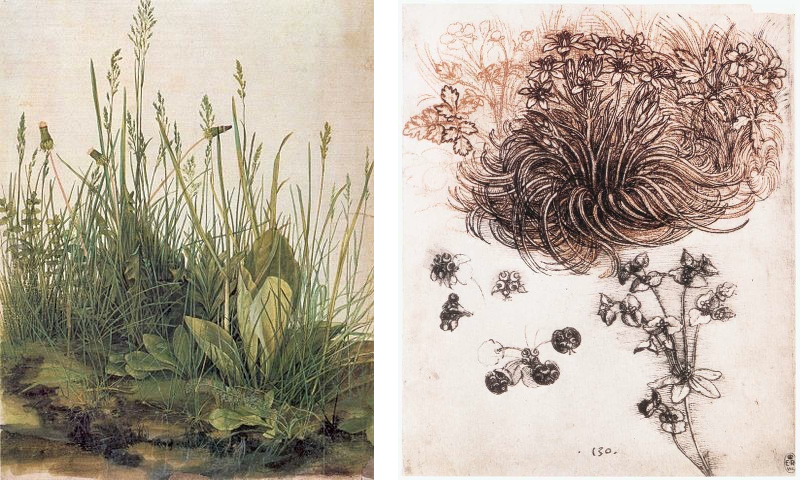
Fig.1. (left) Albrecht Dürer’s The Great Piece of Turf, 1503. Watercolour and opaque, 41×31.5cm. Vienna, Graphische Sammlung Albertina. (right) Leonardo Da Vinci’s Star of Bethlehem, 1510. Pen and ink over red chalk on paper, 19.8x16cm. Royal Library, Windsor.
Dürer’s own pictures from the early 1500s are impeccable representations of his opinion. With almost microscopic observation of detail he produced colourful drawings and watercolours of a number of animals and plants, which he mostly studied from life (Eichberger, 1998, 37; Panofsky, 1955, 80). One such painting is the Little Hare, 1502. He reproduced his “absolute faithfulness to nature” in three stages – after drawing the animal’s outlines, he would colour in its body, and to represent the animal’s fur he would paint every single hair onto the colour wash in full detail, producing the illusion of a real fur coat (Berger, 1994, 82/86).
Another of Dürer’s famous depictions of nature is the watercolour painting of an unobtrusive, rather mundane patch of meadow, called The Great Piece of Turf (1503). It shows a mixed patch of flowers and grasses from the perspective of a small animal (Doyle, 2013, 14). Although microscopes did not exist at the time, Dürer’s drawing looks as though he examined every single blade of grass under the lens of one of them, so that even the different species of plants can be identified – grasses, dandelion, pimpernel and plantain. It was a completely new endeavour, “never before had anyone dared to paint anything as insignificant as a piece of turf” (Berger, 1994, 76).
In the context of naturalistic representation, it is interesting to compare Dürer’s work with that of other contemporary artists. The Italian artist Leonardo Da Vinci shared Dürer’s pursuit of an art that would be universally accepted and executed, “one that constructs representations of all forms in nature on the basis of a profound understanding of natural philosophy in all its relevant facets” (Kemp, 2000, 14). The way in which they interpreted the performance of this art, however, goes into completely different directions. When comparing Dürer’s The Great Piece of Turf with Da Vinci’s Star of Bethlehem (1510), the artists’ different interpretations of similar motifs of the natural world become clear. Whilst Dürer, as explained above, goes into minute detail – individualising each blade of grass, and therefore giving his patch of meadow an individual, distinctive and inimitable character – Da Vinci uses the general principles and characteristics of the plant, so that its representation becomes one that is transferable to all other plants of this species (Kemp, 2006, 178-179). This was a central issue around Dürer’s representations of nature – should the illustrator show the particular specimen he was observing, or should he present “a synthesis of many specimens in such a way as to represent the archetypal form”, as Da Vinci did with his depiction of the Star of Bethlehem (Kemp, 2002, 744)?
Dürer exclaimed that the diversity of nature was such, that every work of art that tried to depict the same natural object would always be a little bit different from the original, “for all out works, none is truly and completely identical with the other” (Dürer in Ashcroft, 2012, 384). This can also be read in another way, namely, that he himself as an artist would never be able to reproduce exactly what he saw in nature, and therefore, he told his readers to try their best, to “look closely at it, take it as your guide, and do not depart from nature” (Dürer in Ashcroft, 2012, 386). His fascination with nature went so far that once he travelled for several days in a boat just to examine and draw the carcass of a whale, which had been washed up on the shores of Zeeland in the Netherlands (Berger, 1994, 13; Eichberger, 1998, 27). Dürer’s numerous studies of nature – animals, landscapes, plants – can be seen as attempts to order and understand what he was seeing, to harmonise the universe, and above all to “reflect a God-given order” (Eichberger, Zika, 1998, 5-6). The combination of his religious faith and his belief in nature can be found in Dürer’s various religious paintings and drawings.
Dürer’s Religion and Nature
Dürer believed that “God had endowed artistic people with very special creative powers” and hence it was the artist’s duty to stay close to nature, “God’s own masterpiece of creation”, and not to venture from it. The artist was to devote his unique powers into depicting nature in the best way possible (Eichberger, 1998, 27). Therefore, he often included his studies of nature in pictures of common Christian imagery. Although this was not the first time animals had appeared in traditional religious paintings, it was the first time they had a realistic look to them.
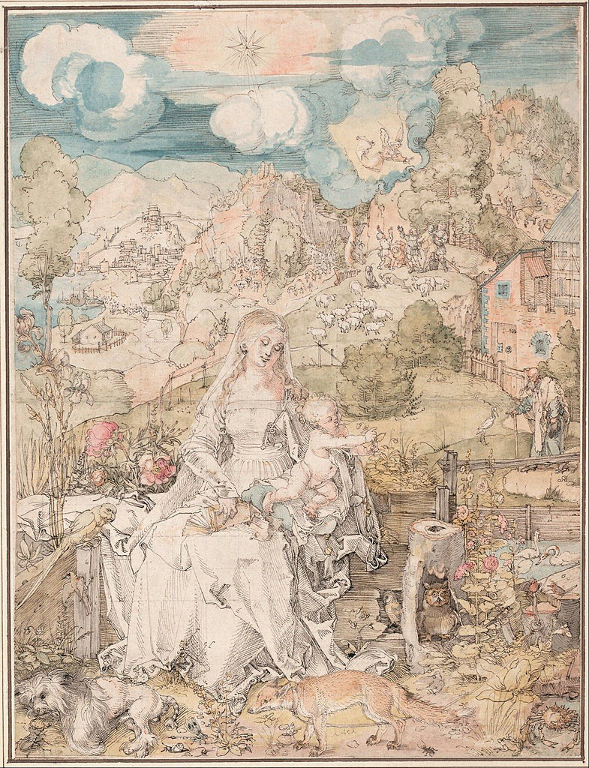
Fig.2. Albrecht Dürer’s Madonna with a Multitude of Animals, 1503. Pen and ink and watercolour on paper, 32.1×24.3cm. Vienna, Graphische Sammlung Albertina.
Even in the middle ages animals appeared in works of art. During that time it was common to give each animal a symbolic meaning – “the Lamb of God; or the lion, ox and eagle represent three of the evangelists” (Sleigh, 2016, 2). So when Dürer inserted animals into his religious paintings many believed that he too, gave them a symbolic meaning. Whether this is true is unknown, but the repetitiveness with which specific animals reappear in his artworks led to the belief that they did embody some form of symbolism (Eichberger, 1998, 30). Especially the appearance of exotic, newly discovered species is somewhat puzzling. Either, Dürer was “eager to incorporate newly gained knowledge and freshly made observations into his pictures” or he wanted to leave some room for interpretation (Eichberger, 1998, 31). Most probably, it was a bit of both. This can be proven by looking at another of Dürer’s paintings.
Dürer’s painting of the Madonna with a Multitude of Animals (1503) illustrates his wish to show as many different species as possible, and also leaves a lot of room for symbolism. The fox at
the bottom of the picture symbolises the evil and sly, but as he is chained, there is no harm in him – rather, his demeanour is one of submissiveness. Therefore, the viewer senses a certain harmony emanating from the painting, “all animals now peacefully coexist in an environment which recalls life before the Fall […] humankind is in harmony with nature, for the image of the Virgin and Child among the multitude of animals seems to offer spiritual place in a time of upheaval and change” (Eichberger, 1998, 37). Not only does the picture speak of harmony within itself, it also reveals the central wish of the Renaissance period – an urge for conformity and for order – in a time of development, expansion, achievements and change.
Another picture dripping with symbolism is Dürer’s print of Madonna with the Monkey (1498). The monkey, in this case, can not only be seen as a symbol of the artist’s interest in exotic species, but can also be interpreted as “the symbol of lewdness and sin” (Eichberger, 1998, 30).
The Place of Dürer’s Paintings in Collections
The discovery of new countries and continents brought with it the trend of collecting. The thirst to capture the ever growing knowledge and to structure and organise it, benefited the artists of that time in several ways. Many specimens were too fragile to be transported across longer distances, others were too valuable. An artist’s job therefore, was – in part – to produce an image that “could stand in for a specimen for the purposes of description and identification” (Sleigh, 2016, 3). The techniques, as described above, used by Dürer were so convincing to the viewer that he felt “the direct experience of the specimen, which no longer needed to be consulted” (Kemp, 2002, 744). An entire new movement developed, in which Dürer’s naturalistic drawings were purchased to subsidise the absence of the ‘real thing’ – the object or specimen – in a collection.
Dürer’s own collection of so-called Naturalia and Artefacta – specimens of rare plants, minerals and exotic animals, and a range of manmade objects – is further proof of his obsession with nature (Eichberger, 1998, 18-19). Most of these items were “received in an almost ritualistic exchange of gifts”, in which Dürer would give away a print or drawing to initiate the exchange of an object. This also meant that he soon developed close contacts with very influential people. As Dürer’s social status grew, so did his collection, and in the mid 1520s he purchased a live Meerkätzlein – a small monkey. By that time he had been studying this species for twenty years, and it had even appeared in his above-mentioned Madonna with the Monkey (Eichberger, 1998, 27-30).
However, this new frenzy of collecting brought with it certain dangers (Kemp, 2002, 744). Dürer mostly made his drawings or paintings using the ‘real thing’ as a model, but at times his interest in the novel specimen got the better of him, and he would create a piece of art based merely on written or visual evidence. So when in 1515 he heard that a real live rhinoceros had been sent as a gift from the governor of Portuguese India to the King in Lisbon, and an eye-witness sent him a detailed note and a drawing to Nuremberg, he immediately set to work (Eichberger, 1998, 16). The resulting picture has the general outline and basic features of a rhinoceros, but its exterior looks more like it is wearing a metal plated armour – “what he did not know of the physical appearance of a rhinoceros is more than compensated for by his imagination” (Bartram, 2011).

Fig.3. Albrecht Dürer’s The Rhinoceros, 1515. The original was a pen and ink drawing. The above is a woodcut print, 23.5×29.8cm. National Gallery of Art, Washington.
As a live rhinoceros had not been seen in Europe for over a thousand years – the specimen for the King never reached its final destination, the Pope, after the ship on which it was being kept sank – Dürer’s print spread across Europe like a wild fire. This was possible, due to the technique of woodcut printing. Between 4000 and 5000 copies of The Rhinoceros (1515) were made in Dürer’s lifetime (BBC, 2011). Unfortunately, this also meant, that whoever saw the print of Dürer’s Rhinoceros believed that this was exactly what the animal looked like, illustrating the central problem of visual representation, “a picture is only as reliable as its network of production and distribution” (Sleigh, 2016, 4).
Representing ‘The Real Thing’ – Perspective and Proportion
Although such lapses, as mentioned above, happened even to the best artists, Dürer was a man of
ability and determination. When he was thirteen years old, he drew a silverpoint self-portrait of himself by observing his reflection in a mirror. It was followed by further self-portraits in 1492, 1498 and 1500 (Ashcroft, 2012, 377). His first is the oldest preserved self-portrait of a European artist (Doyle, 2013, 5). Dürer spoke of them as Konterfei, which means ‘likeness’ or ‘making exactly like’ (Berger, 1994, 12). Again, this proves his conviction to represent the natural world as true as possible.
Dürer was convinced that the key for achieving exactly that – the beauty of nature and its true representation – lay in the mathematical formulas of geometry (Kemp, 2006, 174). Soon after his first visit to Italy around 1500, Dürer began to question his previous works. He now saw them as “powerful but unsound” and, influenced by his Italian contemporaries he began to study the main aspects of Renaissance art theory – human proportions, the proportions of animals and perspective (Panofsky, 1955, 80).
Panofsky gives three reasons why the technique of perspective was received with such a universal enthusiasm. Firstly, the placing of an object anywhere in a picture and the production of a certain distance and point of location symbolised the character of a time in which a “historical distance between itself and the classical past” had given “man a place in the centre of the universe”. Second, perspective “satisfied the new craving for exactness and predictability”. And third, the application of mathematical formulae agreed with Renaissance aesthetics (Panofsky, 1955, 261). Latour tops this theory and states that perspective is a form of fiction, “even the wildest or the most sacred […] things of nature – even the lowliest – have a meeting ground, a common place, because they all benefit from the same ‘optical consistency’. Not only can you displace cities, landscapes, or natives and go back and forth to and from them along avenues through space, but you can also reach saints, gods, heavens, palaces, or dreams” (Latour, 1990, 28). Geometrical longitude and latitude create the perception in the viewer of standing right in the middle of a painting. This also meant that the observer was not detached from the painting anymore, but a full part of it – the artist became a manipulator of visual images, able to “play perceptual games” with the viewer (Scribner, 1998, 104). Dürer’s work on geometry, Instruction on Measurement, is the first document to treat a representational problem with a scientific answer. He points out that perspective is not a technical discipline limited to architecture and painting, but rather an essential part of mathematics (Panofsky, 1955, 253).
Like perspective, proportion also has an underlying mathematical method. What perspective is for the room in a painting, so proportion is for the human or animal body. Dürer sought to set up geometrical explanations for proportions, merging each body part with a geometrical form: “The total length and general axis of the body is determined by a basic vertical […] The Pelvis is described as trapezoid, and the thorax in a square […] The head, if turned in profile, is inscribed in a square, and the contours of the shoulders, hips and loins are determined by circular arcs” (Panofsky, 1955, 262). He soon realised that he could not apply this model to every human being and abandoned the geometrical curves in his drawings, stating that “the boundary lines of a human figure cannot be drawn with a compass of ruler” (Dürer in Panofsky, 1955, 264). Instead Dürer decided to consider a series of female and male body-types, which he assembled in his Four Books on Human Proportion (published posthumously in 1528).
Dürer was influenced by his older contemporary Leonardo Da Vinci. But whilst the latter focused on the underlying structures – muscles, bones and tendons – beneath the observed object, Dürer was more interested in representing the exterior of a given object (Eichberger, 1998, 15). This can be traced back to two interacting points that were very important to him. First, he saw beauty as one of the main features of art, as art is the representation of nature and nature is the product of God – “There is no living person on earth who can say definitively how the most beautiful human form might look. No one but God knows that” (Dürer in Ashcroft, 2012, 381). Second, as his main focus lay in the education of young artists, he saw no point in observing what lay beneath the exterior of an object. To him, geometry was a part of beauty and education, he cautions his young readers to stick to the function, because “what is not functional in a human being is not beautiful. Avoid superfluity” (Dürer in Ashcroft, 2012, 381).
Although the importance of works, such as the Four Books on Human Proportion, might be overlooked or forgotten today, the world of book publishing was revolutionised by the printing press during the Renaissance (Keller, 1972, 13). However, the printing press only allowed the processing of written works and it took time and patience to replicate paintings or drawings (Sleigh, 2016, 7). The most common forms were wood or metal engravings. Most of these wore off easily and did not allow a vast amount of shadowing or detailing. Furthermore, the process of woodcut printing “is one of double reverse”, which means that the original image has to be engraved in reverse onto the wood and is then printed in the right way onto the paper (Sleigh, 2016, 7). Dürer developed the remarkable technique of copper engraving and print – “it allowed the skilled artist to engrave exquisitely thin lines or sets of lines and marks in infinite variety. Thereby, stunning effects of shading, glittering, or even movement, as in animal’s furs can be produced” (Meyer, 2004).
Conclusion
I have shown that Albrecht Dürer was one of the great artists of the Renaissance period. Not only did his artworks embody the Renaissance theories of proportion and perspective, but they also depicted scenes from nature – plants, animals, and landscapes – as realistic as possible. His engraving, drawing and painting techniques were known across Europe and his studies of geometry on the depiction of the human body, meant he was a pioneer in his field. The frequent travels to and from Italy ensured that the Italian Renaissance moved across northern Europe with Dürer as its messenger.
Larissa Warneck (2016)
Bibliography
- Ashcroft, J. 2012. Art in German: Artistic Statements by Albrecht Dürer. Forum of Modern Language Studies, 48(4): 376-388.
- Bartram, G. 2011. A History of the World, Dürer’s Rhinoceros. BBC. [online] at http://www.bbc.co.uk/ahistoryoftheworld/objects/0eHcrXb8RuqIEVYKkExljg
- Berger, J. 1994. Albrecht Dürer. Benedikt Taschen Verlag GmbH. (7-13).
- Doyle, M. 2013. Albrecht Dürer, Master Drawings, Watercolours, and Prints from the Albertina. National Gallery of Art. [online] at https://www.nga.gov/exhibitions/2013/durer/durer.pdf
- Eichberger, D. 1998. Dürer’s Nature Drawings and Early Collecting. Chapter 2 in, ed. Eichberger, D and Zika, C. Dürer and His Culture. Cambridge University Press.
- Keller, A. 1972. Mathematical Technologies and the Growth of the Idea of Technical Progress in the Sixteenth Century. Chapter 2 in, ed. Debus, A.G. Science, Medicine and Society in the Renaissance, Essays to honour Walter Pagel. Heinemann, London. (11-28).
- Kemp, M. 2000. Visualisation, The Nature Book of Art and Science. Oxford University Press.
- Kemp, M. 2002. Naturally Natural, Albrecht Dürer’s Studies of Animals have a Life of their Own. Book Review of Science in Culture. Nature Vol. 420. Nature Publishing Group.
- Kemp, M. 2006. Seen and Unseen – Art, Science, and Intuition from Leonardo to the Hubble Telescope. Oxford University Press.
- Latour, B. 1990. Drawing Things Together. In, ed. Lynch, M. and Woolgar, S. Representation and Scientific Practice. The MIT Press, Cambridge, Massachusetts and London, England. (19-68).
- Meyer, J. 2004. Albrecht Dürer at the Crossroads of Art and Science, Response to Wadsworth. Endeavour. 28(1).
- Panofsky, E. 1955. The Life and Art of Albrecht Dürer. Princeton University Press, Princeton and Oxford. (80-106; 242-284).
- Scribner, B. 1998. Ways of Seeing in the Age of Dürer. Chapter 5 in, ed. Eichberger, D and Zika, C. Dürer and His Culture. Cambridge University Press.
- Sleigh, C. 2016. The Paper Zoo: Introductory Essay. British Library. (1-24).
- Tonelli, F. 2013. Science as Ground of the Renaissance Artists. Clinical Cases in Mineral and Bone Metabolism. 10(1): 68-69.
Pictures
- Albrecht Dürer, The Great Piece of Turf (1503). [online] at https://upload.wikimedia.org/wikipedia/commons/thumb/b/bb/Albrecht_Dürer05.jpg/374px-Albrecht_Dürer05.jpg
- Albrecht Dürer, Madonna with a Multitude of Animals (1503). [online] at http://www.albrecht-durer.org/The-Virgin-among-a-Multitude-of-Animals.jpg
- Albrecht Dürer, The Rhinoceros (1515). [online] at https://upload.wikimedia.org/wikipedia/commons/0/0b/Dürer’s_Rhinoceros,_1515.png
- Leonardo Da Vinci, Star of Bethlehem (1510). [online] at https://upload.wikimedia.org/wikipedia/commons/1/10/Leonardo_da_vinci,_Star_of_Bethlehem_and_other_plants.jpg
Feb 17
From Course to Collider: My adventures at CERN
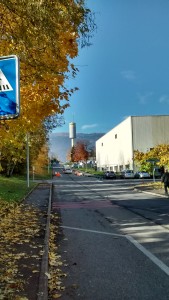 by David Lugmayer
by David Lugmayer
Science can be complex. Even with a lifetime spent studying the sciences one could still not learn everything it has to offer. Yet much of this knowledge can be very important to our lives, whoever we are and whatever occupation we have: This is why we need science communication and is one of the reasons I decided to embark on the Science, Communication and Society MSc program at the University of Kent.
Shortly after I handed in my final dissertation, I became aware of an offer for an internship at CERN in Switzerland. “CERN! That would be a fantastic place to work wouldn’t it?” I thought to myself. But this wasn’t some sort of pipe dream. This, I found, was something I could do: my Science communication course had given me the confidence, the skills and the experience I needed to do this internship. It also involved me writing informative (but easy going) articles, which happened to have been my favourite part of the MSc course. To my delight the application to the internship was accepted, and having recently returned from CERN I feel it went rather well (even if I do say so myself)!
After making the necessary preparations I travelled to CERN (which straddles the Franco/Swiss border) where I would be working for the next two months. The region around CERN has some truly stunning scenery – being nestled between the Swiss Alps and the French sub-alpine mountain range called the Jura, and next to the beautiful city of Geneva and its lake. CERN (which formerly stood for Conseil Européen pour la Recherche Nucléaire but is now called the European Organization for Nuclear Research) is the world’s most eminent organisation for high energy physics research, and is the largest particle physics laboratory in the world. It houses the Large Hadron Collider (LHC) which is comprised of a huge circular tunnel 27km in circumference that runs deep underground; as it happens, the tunnel runs right under the accommodation I was staying in during the internship. The LHC is a particle accelerator that collides two high energy beams of particles travelling close to the speed of light to help answer some important questions, such as the existence of a particle called the ‘Higgs Boson’.
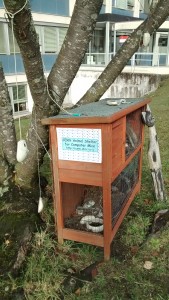
However my role at CERN was not to be directly involved with the physics experiments being conducted. So on a surprisingly mild morning I found myself in an office at CERN’s IT department. My job was to write feature articles for a website called Science Node; which is a joint USA/European hosted website. The website reports on the types of research that has been made available by the use of such things as supercomputing, grid computing, and other forms of high performance computing. It also covers new developments regarding tech trends, the technology community, research networks, and big data. If you are interested in topics such as these, or information technology and science in general, I would highly recommend checking the site out. But, as I soon found out, the site is about much more than this, because some of the research that high performance computing enables is as far removed from the world of IT as you can get.
To write these articles I first had to source some of the weird and wonderful research that relies on these computing technologies. The topics of these articles could encompass almost anything- from unlocking the secrets of photosynthesis, to an amazing project by a school in Canterbury involving a satellite and the youngest ever person to be allowed to use high powered ‘grid’ computing. Once I knew what I would be writing I got into contact with some of the individuals involved, contacting people from all corners of the globe to ask them more about what they had been doing. The purpose of these articles was itself a form of science communication: The site exists to show the world how these advanced computing technologies have affected not just the world of IT, but also the progress of scientific research and understanding.
On the face of it CERN might seem an odd place to work for someone writing articles on a website that is primarily about advanced computing – a subject that falls squarely into the realms of IT. But aside from practical reasons (CERN is one of the sites funding partners) it is actually a very fitting location to host the website. The facility also acts as the main hub for the Worldwide LHC Computing Grid (WLCG): an international grid of over 170 computing centres spread across 42 countries. This vast network of computers is used to process the enormous amounts of information that the experiments produce. My office was in fact located in the building that housed the central datacentre at the heart of the WLCG! There are also other historical reasons that entwine CERN and the world of computing: CERN was the location where Tim Berners-Lee developed the World Wide Web, and published the first ever website.
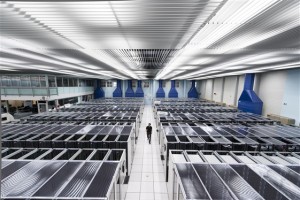
CERN’s data centre
CERN has always been about spreading knowledge. In 1953, the ‘CERN Convention’ was signed, which stated that research conducted there would not be concerned with military requirements, and all its results should be made public. On reflection of the time spent on the internship I came to realise the parallels between the communication of science and the role advanced computing plays at CERN. In the same way that the WLCG boils down the mountains of data produced by the LHC into information that can be used and discussed, science communication plays the role of filtering down the fruits of scientific endeavour into a form that can be consumed and manipulated by everyone.
Jan 25
Science in Public annual conference at Kent
The Centre for the History of the Sciences is pleased to be hosting the 10th annual Science in Public conference this summer. It will be held on 13-15 July 2016 on the University of Kent’s Canterbury campus. We are welcoming proposals for papers and sessions from scholars and practitioners in all fields interested in researching the relationship between science, technology and medicine and their varied publics. Follow the links below for more information and details of our plans for exciting plenary and workshop sessions.
The call for papers is available online here and you can find out more about the Science in Public Research Network by following the link.
Jan 14
Wunderkammer reading group, Spring programme
The Centre for the History of the Sciences’ reading group, meeting alternate Tuesdays, 17:30 in the Unicorn Inn, St Dunstan’s
**except Week 20
26 January 2016 (Week 14) – Technology, Groups & Users
- Christina Lindsay, “From the Shadows: Users as Designers, Producers, Marketers, Distributors, and Technical Support”, in Nelly Oudshoorn and T.J. Pinch (eds), How Users Matter: The Co-Construction of Users and Technologies (Cambridge, Mass.: MIT Press, 2003), pp. 29-50.
- Lars Backstrom et al, “Group Formation in Large Social Networks: Membership, Growth, and Evolution”, in Proceedings of the 12th ACM SIGKDD International Conference on Knowledge Discovery and Data Mining (Philadelphia: ACM Press, 2006) http://www.cs.cornell.edu/~lars/kdd06-comm.pdf.
9 February 2016 (Week 16) – Modernism and Fiction
- Paul March-Russell, “Modernism and Science Fiction” and “Pulp Modernism”, in Modernism and Science Fiction (New York: Palgrave Macmillan, 2015), pp. 1-10 and 85-116. (Paul will join us for this week)
- Sara Danius, “The Antitechnological Bias and Other Modernist Myths: Literature and the Question of Technology”, in The Senses of Modernism: Technology, Perception, and Aesthetics (Cornell University Press, 2002), pp. 25-54.
23 February 2016 (Week 18) – Ian Hacking
- Ian Hacking, Representing and Intervening: Introductory Topics in the Philosophy of Natural Science (Cambridge: Cambridge University Press, 1983), pp. 1-31
- Ian Hacking, The Emergence of Probability: a Philosophical Study of Early Ideas about Probability, Induction and Statistical Inference (Cambridge: Cambridge University Press, 1975/2006), pp. 1-48.
8 March 2016 (Week 20) – Animal Histories Special Event **6pm Grimond Lecture Theatre 2 (GLT2)**
Guest lecture Amanda Rees (University of York):
“Anthropomorphising the Anthropocene: The Pragmatics, Politics and Poetics of Animal Agency”
Book launch with wine reception to follow in honour of Kaori Nagai, Karen Jones, Donna Landry, Caroline Rooney, Monica Mattfeld, and Charlotte Sleigh (eds), Cosmopolitan Animals (Palgrave Macmillan, 2015) and other recent animal publications by Kent staff.
22 March 2016 (Week 22) Euclid in Victorian Education
- Alice Jenkins, “Genre and Geometry: Victorian Mathematics and the Study of Literature and Science”, in Ben Marsden, Hazel Hutchison and Ralph O’Connor (eds.), Uncommon Contexts: Encounters Between Science and Literature, 1800-1914 (London: Pickering & Chatto, 2013), pp. 111-123.
- Joan L. Richards, “Euclid and the English Schoolchild”, in Mathematical Visions: the Pursuit of Geometry in Victorian England (Boston: Academic Press, 1988), pp. 161-200
Readings will be available in hard copy in the School of History Office Post Room. Any queries contact Rebekah Higgitt.
Oct 27
The way things go: science and art
I heard more spontaneous conversations today about science than I have ever heard in any exhibition anywhere.
‘Why are those rings rolling uphill?’
‘Why is that water burning?’
‘What will happen when the balloon fills?’
 I was not at a science exhibition, but at the Turner Contemporary Gallery’s new show, Risk. The piece I was looking at was called The Way Things Go (German: Der Lauf der Dinge), a film made in 1987 by the Swiss artist duo Peter Fischli and David Weiss.
I was not at a science exhibition, but at the Turner Contemporary Gallery’s new show, Risk. The piece I was looking at was called The Way Things Go (German: Der Lauf der Dinge), a film made in 1987 by the Swiss artist duo Peter Fischli and David Weiss.
This film, made in a warehouse, is a sort of mash-up between Blue Peter and Heath Robinson and Wallace and Gromit. It is a continuous stream of actions, each one triggering the next in the chain. Bin bags swing until they stroke tyres to roll; delicately poised and weighted cardboard rings progress up a slope; balloons fill and drop onto levers. Some triggers exploit physical processes – the conservation of energy – while others are chemical: burning, explosion, melting. The whole thing is 30 minutes of cartoonish, breath-holding, audacious inventiveness.
I went with my own children. We joined the video, which was shown on a loop, about 10 minutes in. We watched it to the end, then we watched the first tem minutes to join up to when we started. Then we watched it all the way to the end again. After we’d been round the rest of the show, we came and watched it again. Nor were my children unusual in their attentiveness to the feat which, let’s face it, is not paced like contemporary media. It is slow, and there is no commentary, no music: no sound at all except the drips and clops and fizzings. There was a whole crown of them around the screen and they couldn’t hold their questions back. Some, I’m afraid, were being shushed. The parents were coming back as best they could with fragments of physics and chemistry; the children were filling in with knowledge and hypothesis.
However, despite the science chat the show, and this piece in particular, did not purport to be science; it was art. Moreover, I had the feeling that its success pointed to a very profound asymmetry between science and art in public. When we see science on display – at science museums and expos – there are heaps of explanations: panels to tell us the principles we see on display. Often, we read the panel, then press the button to see the theory demonstrated for us in some clever model. Art is different. Art in galleries is presented with very little explanation. It’s a high risk strategy, with the risk that the audience will write it off with the cliché, ‘my 5-year-old could have made that’. But when it works, it works brilliantly. The audience must do the work of figuring out why it matters; what research underpins it. The audience meets the art in a raw and mostly unmediated encounter. They are not told the answers, but left to figure them out for themselves; indeed, they are left to figure out the questions. In science galleries, by contrast, the encounter is highly mediated; the process or direct results of science are not shown; and the learning outcomes are predetermined. You can either take them, or leave them and proceed straight to the giftshop.
Of course there is always trickery behind the scenes. If you look closely at Fischli and Weiss’s film, there are some cuts, just as there are in science. The results always take a little cleaning up. But somehow seeing that work done in an artistic context changed the way I felt about it.
What I saw at The Way Things Go was, ironically, the best example of science communication I have ever seen – in the specific sense that it got its audience asking questions. I can’t think of any better outcome for a show, whether science or art.
Postscript: You can watch a bit of The Way Things Go on Youtube; better yet, see it in its entirety, and the rest of the exhibition, in Margate.
Oct 01
Wunderkammer reading group – Autumn term programme
WUNDERKAMMER: Centre for the History of the Sciences Reading Group
Alternate Tuesdays, 17:30 in the Unicorn Inn, St Dunstan’s except Week 9
13 October 2015 (Week 3) – Stuff and NonSense
- Samuel J.M.M. Alberti, “Objects and the Museum”, Isis 96 (2005), 559-71.
- Dan Hicks, “The Material-Cultural Turn: Event and Effect,” in The Oxford Handbook of Material Culture Studies, ed. Dan Hicks and Mary Carolyn Beaudry (Oxford: Oxford University Press, 2012).
27 October 2015 (Week 5) – Childish Science
- Melanie Keene, “‘Every Boy and Girl a Scientist: Instruments for Children in Interwar Britain”, Isis 98 (2007), 266-89.
- Alice R. Bell, “The Childish Nature of Science: Exploring the Child/Science Relationship in Popular Non-Fiction’, in Alice R. Bell, Sarah R. Davies and Felicity Mellor (eds), Science and Its Publics (Newcastle: Cambridge Scholars Publishing, 2008), pp. 79-98.
10 November 2015 (Week 7) – Instruments & Observatories
- Simon Schaffer, “Easily Cracked: Scientific Instruments in States of Disrepair”, Isis 102 (2011), 706-17.
- David Aubin, “A History of Observatory Sciences and Techniques”, in Jean-Pierre Lasota (ed.), Astronomy at the Frontiers of Science (Springer Verlag, 2011), pp. 109-21.
25 November 2015 (Week 9) – Slowly Does It **at 14:30-16:00 in CNWsr6
- Great Lakes Feminist Geography Collective, “For Slow Scholarship: A Feminist Politics of Resistance through Collective Action in the Neoliberal University”, ACME (forthcoming).
- Isabelle Stengers, “’Another science is possible!’ A plea for slow science”, Inaugural Lecture for Willy Calewaert Chair (2011).
8 December 2015 (Week 11) – Audiences
- Florence Grant, “Mechanical Experiments as Moral Exercise in the Education of George III”, British Journal for the History of Science 48 (2015), 195-212.
- Aileen Fyfe and Bernard Lightman, “Science in the Marketplace: An Introduction”, in Science in the Marketplace: Nineteenth-Century Sites and Experiences (Chicago: University of Chicago Press, 2007), pp. 1-19.
Everyone is welcome! Readings will be available in hard copy at the School of History Office, or please contact Rebekah Higgitt if you would like more information, to join the Wunderkammer or CHOTS email newslists, or to suggest future readings and themes.

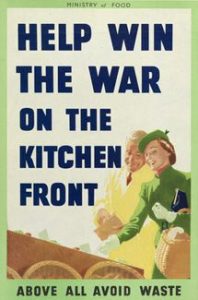

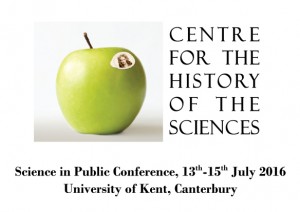
Recent Comments